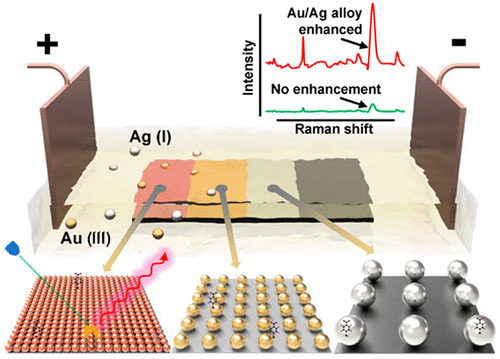Our official English website, www.x-mol.net, welcomes your
feedback! (Note: you will need to create a separate account there.)
High-Throughput Surface-Enhanced Raman Scattering for Screening Chemical Sensor Candidates Enabled by Bipolar Electrochemistry
ACS Sensors ( IF 8.2 ) Pub Date : 2022-04-25 , DOI: 10.1021/acssensors.2c00137 Sanjun Fan 1, 2 , Xinyu Wang 1 , Yingling Li 3 , Xiaofeng Chen 1 , Haotian Chen 4 , Zachary D Schultz 5 , Zheng Li 1
ACS Sensors ( IF 8.2 ) Pub Date : 2022-04-25 , DOI: 10.1021/acssensors.2c00137 Sanjun Fan 1, 2 , Xinyu Wang 1 , Yingling Li 3 , Xiaofeng Chen 1 , Haotian Chen 4 , Zachary D Schultz 5 , Zheng Li 1
Affiliation

|
A variety of hydrothermal or electrochemical methods have been explored to prepare noble metal nanostructures as surface-enhanced Raman scattering (SERS) substrates. However, most of those metallic nanoarrays are structurally homogeneous, which makes it laborious to select the high-performance substrates for particular Raman sensing purposes. Here, a high-throughput SERS imaging strategy is demonstrated for the first time for screening chemical sensors with sub-nanomolar sensitivities. Bipolar electrochemistry was applied to generate Au or Au–Ag gradient nanoarrays with diverse chemical compositions, morphologies, and particle dimensions ranging from several nanometers to micrometers. The selected “hot-spots” on the Au–Ag alloy nanoarray exhibited a 660-fold enhancement in SERS intensity compared to those on the pure Au gradient nanoarray. The SERS screening of 4-aminothiophenol, 4-nitrothiophenol, and 4-mercaptobenzoic acid was carried out that provided a limit of detection (LOD) between 1 and 5 pM. The distinctive LODs among three thiophenolic Raman probes are ascribed to the differences in the affinity of the probe to the alloy, orientation of the metal–ligand monolayer, or plasmonic environment of the nanoarray surface. As a continuous, rapid, and cost-effective manner to fabricate transitional nanostructures and screen out SERS responsive sites, this method not only facilitates controllable synthesis of noble metal nanoarrays but has the potential to provide an alternative tool for ultrasensitive chemical sensing on a wide range of bimetallic substrates.
中文翻译:

用于筛选双极电化学支持的化学传感器候选者的高通量表面增强拉曼散射
已经探索了多种水热或电化学方法来制备贵金属纳米结构作为表面增强拉曼散射 (SERS) 衬底。然而,这些金属纳米阵列中的大多数在结构上都是同质的,这使得为特定的拉曼传感目的选择高性能基板变得很费力。在这里,首次展示了一种高通量 SERS 成像策略,用于筛选具有亚纳摩尔灵敏度的化学传感器。双极电化学用于生成具有不同化学成分、形态和从几纳米到微米的颗粒尺寸的 Au 或 Au-Ag 梯度纳米阵列。与纯金梯度纳米阵列上的那些相比,Au-Ag 合金纳米阵列上选定的“热点”的 SERS 强度提高了 660 倍。对 4-氨基苯硫酚、4-硝基苯硫酚和 4-巯基苯甲酸进行了 SERS 筛选,检测限 (LOD) 介于 1 和 5 pM 之间。三种苯硫酚拉曼探针的不同 LOD 归因于探针对合金的亲和力、金属-配体单层的取向或纳米阵列表面的等离子体环境的差异。作为制造过渡纳米结构和筛选 SERS 响应位点的一种连续、快速且具有成本效益的方法,该方法不仅有助于贵金属纳米阵列的可控合成,而且有可能为大范围的超灵敏化学传感提供替代工具的双金属基板。和 4-巯基苯甲酸进行了检测,检测限 (LOD) 介于 1 和 5 pM 之间。三种苯硫酚拉曼探针的不同 LOD 归因于探针对合金的亲和力、金属-配体单层的取向或纳米阵列表面的等离子体环境的差异。作为制造过渡纳米结构和筛选 SERS 响应位点的一种连续、快速且具有成本效益的方法,该方法不仅有助于贵金属纳米阵列的可控合成,而且有可能为大范围的超灵敏化学传感提供替代工具的双金属基板。和 4-巯基苯甲酸进行了检测,检测限 (LOD) 介于 1 和 5 pM 之间。三种苯硫酚拉曼探针的不同 LOD 归因于探针对合金的亲和力、金属-配体单层的取向或纳米阵列表面的等离子体环境的差异。作为制造过渡纳米结构和筛选 SERS 响应位点的一种连续、快速且具有成本效益的方法,该方法不仅有助于贵金属纳米阵列的可控合成,而且有可能为大范围的超灵敏化学传感提供替代工具的双金属基板。金属配体单层的取向,或纳米阵列表面的等离子体环境。作为制造过渡纳米结构和筛选 SERS 响应位点的一种连续、快速且具有成本效益的方法,该方法不仅有助于贵金属纳米阵列的可控合成,而且有可能为大范围的超灵敏化学传感提供替代工具的双金属基板。金属配体单层的取向,或纳米阵列表面的等离子体环境。作为制造过渡纳米结构和筛选 SERS 响应位点的一种连续、快速且具有成本效益的方法,该方法不仅有助于贵金属纳米阵列的可控合成,而且有可能为大范围的超灵敏化学传感提供替代工具的双金属基板。
更新日期:2022-04-25
中文翻译:

用于筛选双极电化学支持的化学传感器候选者的高通量表面增强拉曼散射
已经探索了多种水热或电化学方法来制备贵金属纳米结构作为表面增强拉曼散射 (SERS) 衬底。然而,这些金属纳米阵列中的大多数在结构上都是同质的,这使得为特定的拉曼传感目的选择高性能基板变得很费力。在这里,首次展示了一种高通量 SERS 成像策略,用于筛选具有亚纳摩尔灵敏度的化学传感器。双极电化学用于生成具有不同化学成分、形态和从几纳米到微米的颗粒尺寸的 Au 或 Au-Ag 梯度纳米阵列。与纯金梯度纳米阵列上的那些相比,Au-Ag 合金纳米阵列上选定的“热点”的 SERS 强度提高了 660 倍。对 4-氨基苯硫酚、4-硝基苯硫酚和 4-巯基苯甲酸进行了 SERS 筛选,检测限 (LOD) 介于 1 和 5 pM 之间。三种苯硫酚拉曼探针的不同 LOD 归因于探针对合金的亲和力、金属-配体单层的取向或纳米阵列表面的等离子体环境的差异。作为制造过渡纳米结构和筛选 SERS 响应位点的一种连续、快速且具有成本效益的方法,该方法不仅有助于贵金属纳米阵列的可控合成,而且有可能为大范围的超灵敏化学传感提供替代工具的双金属基板。和 4-巯基苯甲酸进行了检测,检测限 (LOD) 介于 1 和 5 pM 之间。三种苯硫酚拉曼探针的不同 LOD 归因于探针对合金的亲和力、金属-配体单层的取向或纳米阵列表面的等离子体环境的差异。作为制造过渡纳米结构和筛选 SERS 响应位点的一种连续、快速且具有成本效益的方法,该方法不仅有助于贵金属纳米阵列的可控合成,而且有可能为大范围的超灵敏化学传感提供替代工具的双金属基板。和 4-巯基苯甲酸进行了检测,检测限 (LOD) 介于 1 和 5 pM 之间。三种苯硫酚拉曼探针的不同 LOD 归因于探针对合金的亲和力、金属-配体单层的取向或纳米阵列表面的等离子体环境的差异。作为制造过渡纳米结构和筛选 SERS 响应位点的一种连续、快速且具有成本效益的方法,该方法不仅有助于贵金属纳米阵列的可控合成,而且有可能为大范围的超灵敏化学传感提供替代工具的双金属基板。金属配体单层的取向,或纳米阵列表面的等离子体环境。作为制造过渡纳米结构和筛选 SERS 响应位点的一种连续、快速且具有成本效益的方法,该方法不仅有助于贵金属纳米阵列的可控合成,而且有可能为大范围的超灵敏化学传感提供替代工具的双金属基板。金属配体单层的取向,或纳米阵列表面的等离子体环境。作为制造过渡纳米结构和筛选 SERS 响应位点的一种连续、快速且具有成本效益的方法,该方法不仅有助于贵金属纳米阵列的可控合成,而且有可能为大范围的超灵敏化学传感提供替代工具的双金属基板。











































 京公网安备 11010802027423号
京公网安备 11010802027423号